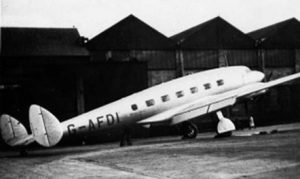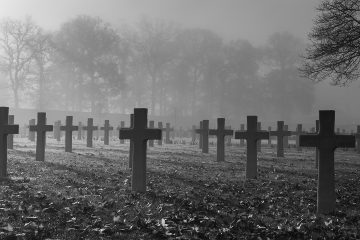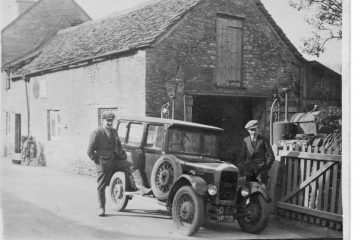The Albatross at Burton
blog by Ian Wilson
Unlikely as it may seem, Burton was once host to an airliner for a while, when a de Havilland Albatross named Fingal was stored at the garage following a forced landing at Pucklechurch.

The Albatross
The Albatross was a 22-seat airliner which had entered service in 1937. Seven were built, all with names starting with ‘F’. Imperial Airways named the fleet the Frobisher class after the first to be delivered. The type was designed by Arthur Hagg who was renowned for creating elegant aeroplanes and the Albatross was widely acclaimed for its pleasing lines. In fact his greatest contribution to aviation history wasn’t the aircraft he designed but an invisible development which is still used today, his invention of differential ailerons whereby in a turn the ‘up’ aileron moves more than the ‘down’ one, improving handling and reducing drag.
At the outbreak of war the fleet was impressed into military service and based at Bristol’s Whitchurch airport, where Frobisher was lost in a bombing raid.
On 6th October 1940 Fingal was carrying a group of Royal Navy personnel east of Bristol when failure of a fuel line caused loss of power on all four engines. Farmer Jack Boulton was potato harvesting with a horse and cart, assisted by a boy of below military age, when he saw the aircraft low over Abson. It disappeared from view then re-appeared straight over them at hedge-top height before landing just before the Hinton – Pucklechurch lane (continuation of Toll Down Road out of Burton). Fingal crossed the lane and came to rest against a cottage. Once the pilot had assured himself his passengers were safe he hurried up the field believing he had struck the group working there. In fact they were shaken but unharmed. Unsurprisingly the horse had reared and was not amused but no real damage was done.
Fingal was dismantled and taken to Burton pending assessment as to whether repair was viable. Bringing major sections up Hinton Hill with its tight bends must have been challenging. Eventually the wooden structure was deemed uneconomic to repair and Fingal was scrapped. Indeed that same structure was not standing up well to military service. Three others had been lost in accidents and the last two were withdrawn in 1943. In any case they were no longer needed as the RAF now had larger and more robust Dakotas, eventually around 1,900, which could also tackle tasks like glider towing and paratroop dropping which the Albatross could not handle. So durable were the Dakotas (or civilian DC-3s) that to this day from the Arctic to Antarctic, from Canada to Colombia, some of these fine old workhorses remain in daily use.
Article written by Ian Wilson


3 Comments
Amanda Read · 01/19/2022 at 6:52 am
Clear and concise, interesting and entertaining. I hope Ian Wilson writes some more blogs for the website.
Pomme Homme · 03/23/2023 at 3:58 pm
Is it known whether Jim Packer acquired the remains of the Albatross in situ and then, speculatively, dismantled and conveyed them from Pucklechurch to Burton? It seems improbable that if the Albatross remained in the ownership of BOAC (ownership was transferred to it from Imperial Airways on 29 August 1940), it would have moved the airframe the eight miles from Pucklechurch to Burton in order to assess the feasibility of its restoration to airworthiness. Far more likely is that it would have moved it to Whitchurch Airfield, Bristol, where there would have been the engineering facilities to undertake this task. So if Jim Packer acquired it speculatively, who assessed it as being beyond economic repair? It’s improbable that Jim Packer had the qualifications and skills to do so. Maybe he brought in someone who had those hoping that, if the assessor gave the ‘thumbs up’, he would be able to sell the airframe on at a profit? It would be fascinating to know but, I fear, the reality is that this part of the story has fallen victim to the passage of time!
Pomme Homme · 04/16/2023 at 9:40 pm
From Air Pictorial, September 1966:
‘The remains of Fingal were sold as scrap to Mr C.J.Packer, who owned a small garage in the village of Burton, near Chippenham, Wiltshire. The centre section of the fuselage was used as a storeroom until, finally, it was chopped up for firewood towards the end of 1946.’